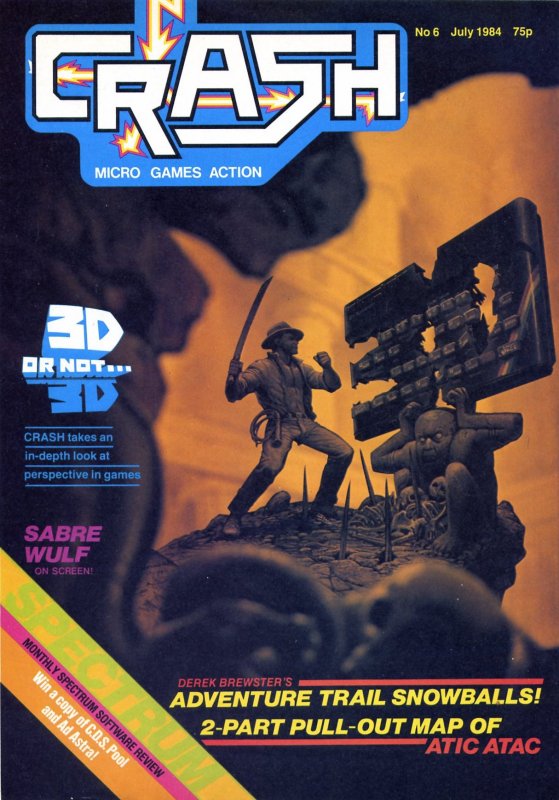

This cover is unique, for to date it is the only one that is actually a photograph, albeit one of Oliver’s artwork. Relating to an article about 3-D games, the picture’s theme was taken from the newly released film Raiders Of The Lost Ark. ‘Indie’ is seen threatening a statue bearing a Spectrum, ravaged to form the characters 3D. The foreground and background were also painted artwork, but when the three layers were set up one behind the other rather like a cardboard stage set, the soft focus created a three-dimensional effect.
CRASH was rapidly expanding, both in scope and in the people who worked for it, at least on a casual basis. As Kean, Frey and Western fiddled around in the ‘studio’ (in reality Roger’s bedroom) setting up the various bits and pieces for the cover shot and getting the lighting and focus just right, downstairs another mail-order-buying youngster tried his hand at writing a test review (of Rabbit’s dreadful Deathstar, if my memory serves). He was 13-year-old Robin Candy, who, to his eternal embarrassment, appeared in a photograph sitting cross-legged on a Spectrum wearing a CRASH T-shirt as part of the Hotline spread.
Roger reckoned the test was satisfactory, and Robin joined the reviewing team along with Matthew Uffindell, Chris Passey and one or two other Ludlow locals.
Three other newcomers made their first appearance, Signpost in the Adventure Trail, Ultimate’s enduring Lunar Jetman comic strip drawn by John Richardson, and at the end of the Playing Tips, my Hall Of Slime, which lasted up until recently when I thought it had finally had its day. Nearly every other magazine ran high-score tables for readers, usually called Hall Of Fame or Roll Of Honour. When asked to do the same in CRASH I thought it would be boring to repeat the formula, and since none of the scores printed elsewhere seemed to be checked out for truthfulness (and how can you all too often?), and the whole high-scoring ethos seemed reminiscent of ‘creeping’ at school, I opted for the Hall Of Slime — a special home for high-scoring creepie-crawlies. It worked a treat!
The centre spread saw our first ever colour map, part one of the Atic Atac plan, done with the help of competition entries. But the amazing feature of this issue was the mammoth article Roger prepared on 3-D games to date. 14 pages long, it examined the nature of 3-D perspective and then showed how each form had been implemented on the Spectrum through some 60 games. Once again, in many respects it was a ‘first’; no other entertainment computer magazine had ever attempted such an exhaustive, or long, feature before. And it went against the traditionalist grain — publications aimed at a teenage market were supposed to present short, snappy articles in recognition of the short attention span of young people. It was an outmoded concept CRASH threw away, we all believed our readers capable of reading long, detailed and intelligent pieces (even when we were often forced to listen to some surprisingly fluent obscenities on the Hotline answering machine!).
Despite the onset of the summer months, software was holding up well. Five games were Smashed, the oddly-named Worse Things Happen At Sea from Silversoft, which was maddeningly addictive and funny, Bug Byte’s Antics, the very playable high-scoring game Moon Alert from Ocean, an adventure Smash in Level 9’s Snowball — first of the famous trilogy — and the dubiously-acclaimed Sabre Wulf from Ultimate. There’s no doubt it should have been a Smash — it’s just that it arrived so late in the month we hardly had time to play it enough, and copped out by not rating it at all!
Up until this moment, CRASH had been produced from a house, really from just two small rooms, but the company’s finances had improved sufficiently to afford proper offices. As Issue Six came towards completion, Newsfield leased three floors of a building in Ludlow. We were all looking forward to being able to stretch out a bit, to be able to write and do the artwork in less cramped quarters.